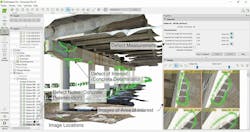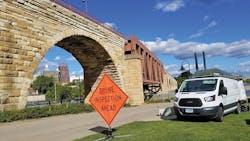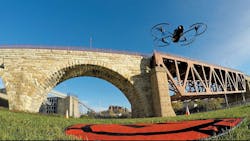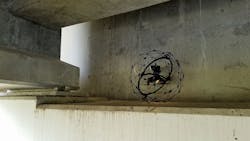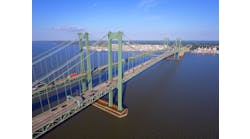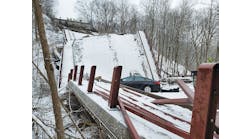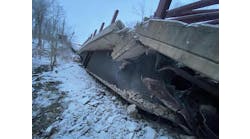By: Barritt Lovelace, P.E., and Jennifer Wells, P.E.
The ability to collect and process large amounts of data is transforming our world.
Many industries including healthcare, finance, energy, communication and transportation are finding ways to utilize data to improve people’s lives. The Minnesota Department of Transportation (MnDOT), in coordination with Collins Engineers Inc., is employing drones to collect and process large amounts of data from bridge inspections with the goal of improving inspection quality, reducing safety risks and minimizing inspection costs.
Bridges are a key part of our transportation system, and maintaining this infrastructure is important to ensure the safety of the traveling public as well as to maximize the useful life of these valuable assets. The most important objective of a safety inspection is to verify the structural integrity of the bridge. Information gathered during bridge inspections is used to give bridge owners and engineers the necessary data to plan for the maintenance, rehabilitation and/or replacement of bridges. The National Bridge Inspection Standard (NBIS) sets minimum requirements for bridge inspections including inspector qualifications, inspection intervals and inspection procedures. The NBIS was implemented into federal law in 1968, and bridge inspections have largely been performed in a similar manner until now. One of the key contributing factors to the success of the National Bridge Inspection Program is the ability to collect quality data on the nation’s bridges. Drones are a platform for collecting data, and the use of this technology satisfies one of the primary goals of the NBIS. Inspection-specific drones are proving to be an effective tool that can collect high-quality inspection data. Software is now available to process the data collected by drones into deliverables that assist bridge owners in making better risk-based, data-driven decisions.
Moreover, the Federal Highway Administration (FHWA) has identified this technology as a tool that can provide benefits for bridge inspections and the transportation industry in general. In the hands of qualified and experienced bridge inspectors, drones have the ability to improve the safety and quality of inspections. As the FHWA moves towards risk-based inspections, drones are playing an important role in bridge inspections as a tool for an experienced and qualified bridge inspector.
The senseFly Albris UAV inspects the Stillwater Lift Bridge in Minnesota.
The right model
Inspection-specific drone technology is maturing, and several drone models now exist that serve the inspection and asset-management industry. These drones include features important to bridge inspection such as sense-and-avoid, infrared imaging, autonomous flights, and collision-tolerant features. Inspection-specific drone models have their own strengths and weaknesses, but all can accomplish the task of obtaining high-quality data. As technology has improved, the focus has shifted from the ability to collect data to making effective use of the data.
The senseFly Albris drone has been used extensively and successfully in completing inspections on a wide variety of bridge types. The ultrasonic sensors enable the drone to lock on to the bridge at a fixed distance, and in combination with autonomous flights and the cruise-control feature, the drone effectively becomes an airborne scanner collecting data to produce photorealistic, dimensionally correct 3-D models of the bridge.
Most drones available are not designed for the confined or congested areas that are often found on bridges. An important focus of recent MnDOT research was identification of a drone that could accomplish this challenging task. The Flyability Elios drone was identified and tested extensively on a wide variety of bridges. This collision-tolerant drone solves the issue of accessing those difficult-to-reach areas by employing a cage around the drone that enables the drone to come in contact with the structure, and even use the structure itself to fly and navigate. One use case that emerged as valuable to bridge inspection is the ability to fly between beams and through diaphragms. The majority of bridge superstructures in Minnesota are comprised of multiple beam lines. These bridges have redundant load paths, making them lower risk compared to other bridge types. Since Under Bridge Inspection Vehicles (UBIVs) and traffic control are expensive, many of these bridges do not get a close-up inspection. The collision-tolerant drone provides an effective, safe and cost-effective way to inspect these bridges. The use of these types of drones also may reduce the need for expensive access methods and traffic control. Combined with typical inspection-specific drones such as the senseFly Albris drone, engineers can now achieve 100% inspection coverage of a bridge.
The MnDOT team has successfully been using Pix4D software to process bridge inspection data.
The components of success
Effective bridge inspections are comprised of three key components. The first component is the ability to detect deficiencies. In order to be successful in this endeavor, the bridge inspector’s experience and knowledge play a key role. Access to bridge components is vitally important and UBIVs, lifts, rope access, scaffolding, and ladders have been the traditional tools used to gain access to observe bridge components. These methods are effective but can be costly and pose safety challenges not only to inspectors but to the traveling public. Utilizing drones for bridge inspections can improve safety and reduce costs by reducing or eliminating the need for expensive access equipment and reduce the need for lane closures and traffic control.
The second component of an effective bridge inspection is the ability to document deficiencies. Traditionally this has been accomplished by documenting the inspection with detailed notes and photos. While this method is effective, the results of the MnDOT work has identified methods that greatly improve the documentation of defects with the use of drone imagery in addition. Bridge inspectors now have the ability to create photorealistic 3-D models of an entire bridge or a particular component of the bridge. The Minnesota team has been successfully using Pix4D software to process the data into deliverables that can be incorporated into reports or replace the reports entirely. These models and associated deliverables are dimensionally correct and can be used to measure and annotate defects, which saves time in the field and improves the accuracy of the results.
Utilizing drones for bridge inspections can improve safety and reduce costs by reducing the need for lane closures and traffic control.
The final component of a successful inspection is the ability to clearly communicate inspection results to bridge owners, engineers and decision makers. Traditional methods have included paper and electronic database reporting. This research effort has demonstrated more effective ways to communicate inspection data by employing recent advancements in the reality modeling of bridges and inspection data. These new methods are improving the ability for bridge inspectors to clearly communicate inspection results and ensure better translations of results for better decisions. Since we are collecting large amounts of data and generating bridge models that can both be difficult to share, finding ways to easily share the inspection results is crucial.
The Minnesota team has accomplished this effort by utilizing the cloud-sharing platform from Pix4D. Thus, the inspection results can be shared simply by sending a link to the inspection model. The bridge owner can view the model and inspection annotations. The owner also can view any of the inspection photographs by simply clicking on an area of interest on the model, which will then display all of the images taken of that particular area. This 3-D photolog eliminates the need to annotate each individual photograph taken during the inspection, which saves time when preparing the report and also is a more efficient way to find images or particular bridge components.
The senseFly Albris drone inspects the Stone Arch Bridge in Minneapolis.
Going further
MnDOT and Collins Engineers are implementing drones on bridge inspections to improve safety, quality and also to reduce costs. Data is collected in the field after careful planning. An inspection and safety plan is prepared that considers inspection goals, airspace requirements, equipment, personnel and a job hazard analysis. The actual inspection is performed by a minimum of two individuals including a qualified pilot and a visual observer. One or both of the individuals should be a qualified bridge inspector. A typical inspection will consist of preplanning and programming any autonomous missions that will be performed. Once in the field the site is assessed for hazards, and an operating area is chosen. Equipment is set up including a mobile flight station. An on-site safety meeting is conducted to review safety protocols and the mission scope. All of the equipment is checked and a backup independent controller is readied. The operating area is delineated with safety cones, so anyone passing by does not enter the landing zone. The drone is then flown to collect data and observe areas of the bridge identified in the planning. The drone itself is flown to scan the areas of interest using an autonomous preprogrammed mission or utilizing the drone’s cruise control and distance-lock features. The visual observer monitors the drone in the air while the pilot also monitors the live video and flight controls. Any deficiencies discovered in the field are noted and documented. Once all of the data is collected, it is brought back to the office for processing.
Drones fit very well into the inspection workflow, but it must be understood that they are a tool for qualified and experienced inspectors—and not a replacement. Each bridge is unique, and there are opportunities to incorporate drones on many bridges. Fracture-critical or high-risk bridges will continue to rely mainly on traditional inspection methods, but even on these bridges, drones can help engineers to better document the inspection and to better communicate the results. Bridge owners should consider their use where the quality can be improved and where safety risks can be reduced. For many bridge inspections, the use of UAS can eliminate or reduce the need for access vehicles and/or lane closures, thereby significantly reducing risk.
This research effort implemented UAS technology on over 50 bridges, covering a wide range of bridge sizes, types and locations. The results of this research effort have demonstrated that drone technology and processing software are effective tools to improve the quality of bridge inspections in addition to improving safety and reducing costs. Traditional access and reporting methods will continue to be utilized even as UAS technology improves, but UAS has proven to be an effective tool.
It is an exciting time to be a bridge inspector. The team is currently finishing the third phase of its research. MnDOT and Collins Engineers are continuing to implement this technology on more bridge inspections with plans to further integrate drones into their inspection programs in order to realize the full benefits of the technology. In this regard, the sky’s the limit.
The Flyability Elios drone was identified by MnDOT as a UAV that could work for the confined or congested areas often found under bridges.
About The Author: Lovelace is regional manager with Collins Engineers Inc. Wells is a state bridge inspection engineer for the Minnesota Department of Transportation.


